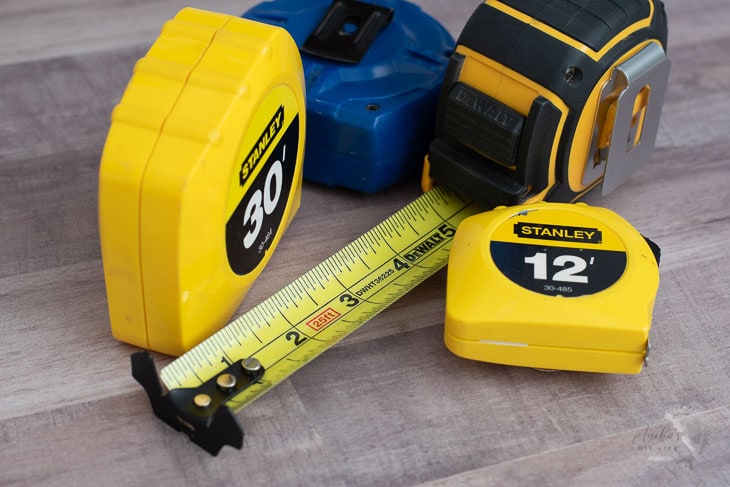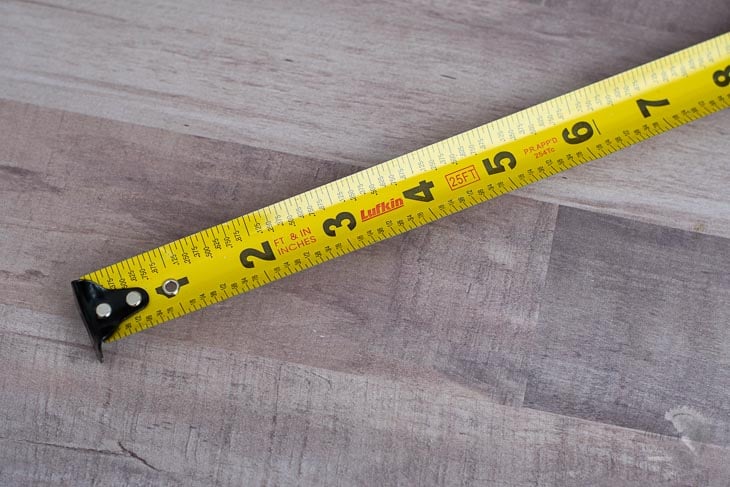How to Read a Tape Measure
Does a seemingly simple tool like a tape measure feel incredibly frustrating? Learn how to read a tape measure accurately and discover the hidden clever features to help you get the most out of it.

If there is one crucial basic tool you need to make or build anything – it’s the tape measure! Measuring and marking accurate readings is extremely important to get the best results from your DIY projects, whether it involves mounting a picture frame, adding board and batten walls, or building a cabinet.
Measuring tape reading might seem like a no-brainer at first glance, but all those marks, symbols, and fractions can make your head spin when you try to use one in a pinch – just ask me. I grew up in the metric system, so any measurement under a 1/4″ has me cross-eyed and counting lines – 2 ticks past the 1/8″ mark, anyone?
But once you know what to look for, reading a tape measure becomes quite simple. So, in this article, I will discuss everything you need to know about tape measures and offer tips for getting the best and most accurate reading.
But once you know what to look for, reading a tape measure becomes quite simple. So, in this article, I will discuss everything you need to know about tape measures and offer tips for getting the best and most accurate reading.
Table of Contents
Tape Measure Parts
Every tape measure has a few basic parts. Depending on the model and manufacturer, they might differ in the look and how they operate, but their essential functions remain the same.

The Tape
The heart of the tape measure is the tape, a flexible ruler made of fiberglass or metal. It can be pulled out or retraced into the case. When extended, it has a slight convex curve, which gives it rigidity.
Specialized home improvement and woodworking versions are usually yellow and have special markings for stud intervals and truss locations.
The Case
The case is the housing for the measuring tape. It is made of plastic or metal. It can come in various sizes depending on the length of tape it needs to house.
The Metal Tab Hook
At the front of the tape is a metal tab with many handy uses. One of the main things you will notice is that the metal tab moves. You may think it is broken, but this is actually intentional and makes it easier to get accurate tape measure readings. More on that below.
The Thumb Lock
The thumb lock helps hold and lock the tape in an extended state to help with measurements. Once the measurement is completed, you can release the thumb lock to retract the tape. Be careful, though. The tape can retract really fast and pinch your skin.
The Belt Clip
The belt clip on the back of the case can be hooked onto your apron or tool belt to help keep your tape measure close!
How to Read Tape Measure Lines
Learning how to read tape measure markings is all about basic division. Most Imperial-based tape measures will go down to 1/16 of an inch, but some will go as far as 1/32”. Here is what all those tape measure marks mean:
- Whole-Inch Markings: The longest lines on the tape measure represent whole inches. These lines typically have large numbers next to them, indicating the inch.
- Half-Inch Marks (1/2″): The second-longest lines between the whole inches. For example, halfway between 1″ and 2″ is 1 1/2″.
- Quarter-Inch Marks (1/4″): The next-longest lines appear between each half-inch mark. You will find them at ¼” and 3/4″.
- Eighth-Inch Marks (1/8″): These are even shorter and sit halfway between each quarter-inch mark. They appear at 1/8″, 3/8″, 5/8″, and 7/8″.
- Sixteenth-Inch Marks (1/16″): The shortest lines, appearing halfway between each eighth-inch mark. They mark 1/16″, 3/16″, 5/16″, 7/16″, 9/16″, 11/16″, 13/16″, and 15/16″.
- Thirty-Second Inch Marks (1/32”): These lines aren’t on every ruler, but if you see them on your tape measure, they will be the smallest and sit between each sixteenth-inch mark.
As for how to use a tape measure to determine distance, simply count the smaller marks from the nearest whole inch.
For example, if you have a measurement that is three marks past the 1-inch line:
- The first mark past 1″ is 1 1/16″.
- The second mark past 1″ is 1 1/8″, or 2/16”.
- The third mark past 1″ is 1 3/16″.
So, your measurement is 1 3/16″.
If your fraction homework from grade school is still not fresh in your mind, don’t worry – it takes some practice to read tape measure markings and figure out the fractions quickly, but it gets easier with time!

How to Read Measuring Tape Accurately
Getting accurate measurements doesn’t only involve reading the measuring tape numbers. There are other factors to remember to get the most exact measurement.
To keep your tape measure working properly, treat it gently and protect it like your child – don’t let the tape twist or bend, as this can damage it and ultimately lead to inaccurate measurements.
Here are a few more details to pay close attention to so you get the most accurate readings:
- Keep the tape straight – When measuring, keep the tape completely straight – in all directions.
- Any sagging will make the measurements inaccurate.
- If the tape is at an angle, the measurement will be inaccurate.

- Burn an inch – If your tape measure is old and you aren’t confident about its accuracy, start measuring at 1″, then subtract 1″ for the final measurement. Note: this only works for smaller objects.

Tape Measure Safety
Yes, you read that right! Though seemingly harmless, there are a couple of safety measures to follow while using a tape measure.
Very important – don’t let the tape reel back into the case at warp speed.
The metal tape can be extremely sharp (think paper cut but with metal!). It can cause bruises if left to recoil uncontrollably. It can also flail around hitting others or surroundings. It can also flail around and hit other people or objects in the surrounding area.
To safely recoil the tape measure, hold it near the mouth of the case and use your fingers to control the speed at which it retracts.
Tape Measure Features You Should Know
Tape measures have plenty of hidden features that make reading them more accurate and assist you in other ways as you work.
1. Why Is the Tape Measure End Loose?
I can’t tell you how many times I have heard – “Is my tape measure broken? Why is this silver tab moving so much?”
No. The tape measure is NOT broken. That silver tab is meant to move! In fact, its motion helps you get accurate readings. This is one of the tape measure’s most important and genius features.

The distance the tab moves is equal to the thickness of the tab.
When you pull to measure, the tab extends out so the zero starts on the inside edge of the tab.

When you push to measure – like inside a box – zero starts at the outside edge of the tab.

It is a simple feature but makes a HUGE difference in the accuracy of the tape.
2. Why Is There a Hole in the Tab?
The hole in the tab can help with 2 things –
- Hook it – if measuring from the middle of a surface and your arms are not long enough to reach the other end, simply add a nail or thin screw to hook the tab onto and measure.

- Making circles – With the tab hooked on the nail/screw, you can hold the pencil to the desired reading to draw a circle at any size.

3. What is the Number of the Case?
The number on the case denotes the length of the case itself.

If you have to measure inside a box or window frame, you can rest the entire tape measure inside and include it in your measurements by adding it to the number on the tape.

For example, my tape measure is 3-3/8″ wide. The above measurement will be 30-1/2″ + 3-3/8″ = 33-7/8″.
4. What Is the Black Diamond on the Tape Measure?
The black diamonds are the truss spacing. Each black diamond is 19.2″ apart and will appear at those multiples until 96″, or 8′.

Typical stud spacing is 16″, so you will find many measuring tapes that mark the 16″ increments with red boxes in addition to the black diamonds.
Apart from these, every tape has the total length of the tape written at the very beginning.
5. Makeshift Marking Tool
Ever lost a pencil in the workshop? In a pinch, the sharp ends of the tab at the end of the tape measure can act as a marking tool by scraping a mark into whatever medium you’re working with.
My Favorite Tape Measure
If you are still getting used to deciphering the lines and fractions, you may prefer a tape measure with the fractions already marked! What’s even better is to have the decimal equivalents of each fraction marked on the tape measure as well.
This tape measure has everything you need, and while it might not be the most heavy-duty option, it definitely makes measuring completely hassle-free.

What do you think?
Was this article helpful? Aren’t these little hidden features super-clever?!
More Beginner Woodworking Articles
Anika's goal is to inspire and empower beginners with woodworking, DIY, home improvement, and home decor ideas.
She wants everyone to unlock their creative potential and experience the feeling that comes with making something. Nothing feels better better than seeing something and saying "I can make that!"














Excellent information and impressive pictures, I thought my tape has defective tab. This information made me clear off so many doubts and also new information. I’m kind of still adjusting to imperial units kind of confusing.
Well I, for one, learned a lot from this post; for instance I didn’t realize that ‘our’ system of measurement is called ‘imperial’ as opposed to metric! I grew up learning the ‘imperial’ way of measuring, and everybody else groaned when the teacher told us to learn the metric system, since it was far more precise! But wouldn’t you know it, I was too stubborn to try. And I’m too old now. Ha! I appreciate this post considerably, and will do my best to commit it to memory!
Excellent, simple & very useful explanation. I knew some of the tape features, but she brought out some I hadn’t paid attention to. Thanks for the tips.
Amazing work!! Looking for more from you.